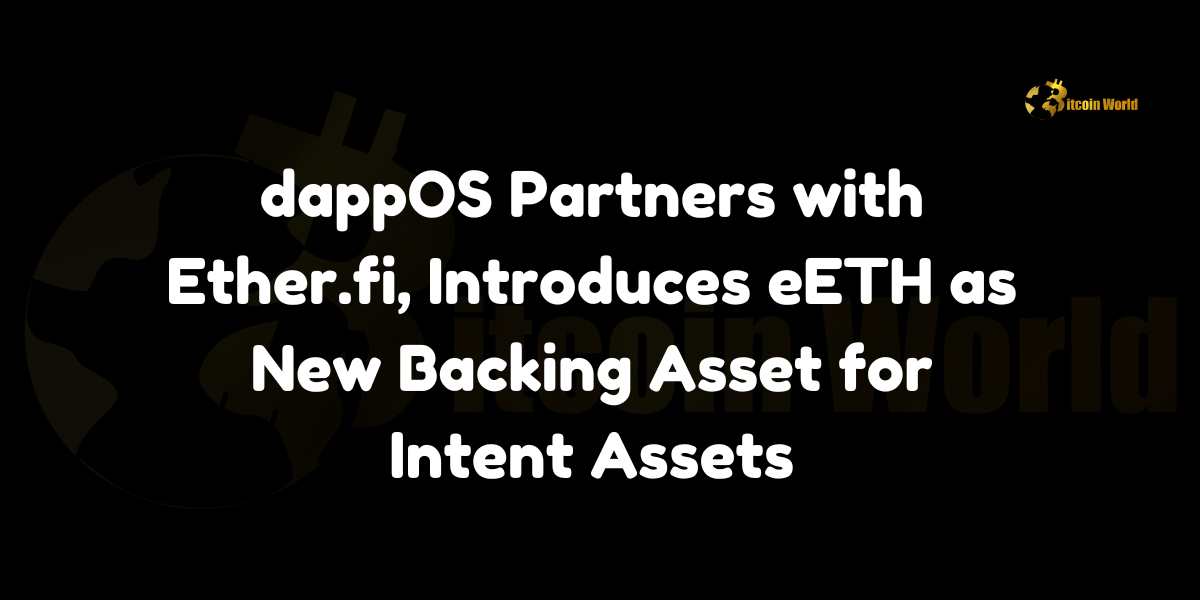dappOS Ether.fi eETH backing asset integration marks a significant milestone for decentralized application infrastructure and liquid staking. In a recent Medium blog post, dappOS, a decentralized application infrastructure protocol, announced its strategic partnership with Ether.fi, a liquid staking protocol on Ethereum. This collaboration introduces eETH as a new backing asset for dappOS Intent Assets (IA), expanding the protocol’s ecosystem and enhancing its yield-generating capabilities.
eETH as a Backing Asset
The partnership allows users to mint eETH by staking their Ethereum (ETH) through Ether.fi’s liquid staking protocol. Once ETH is staked, it automatically accrues staking rewards, providing users with a passive income stream. The earned rewards are then restaked in EigenLayer, an Ethereum-based re-staking protocol that maximizes yield generation.
- Minting eETH: Users can stake ETH to mint eETH, which can be used as collateral within the dappOS ecosystem. This integration allows users to unlock liquidity from their staked assets while continuing to earn staking rewards.
- Automatic Restaking for Continuous Yield: The partnership enables automatic restaking of eETH in EigenLayer, ensuring continuous yield generation. This streamlines the staking process for users, allowing them to maximize returns without manual intervention.
Benefits for dappOS and Ether.fi Users
The dappOS Ether.fi eETH backing asset integration offers several advantages for users in both ecosystems:
- Enhanced Yield Opportunities: By leveraging Ether.fi’s liquid staking capabilities and EigenLayer’s restaking infrastructure, users can benefit from higher yields on their staked ETH, creating a more efficient way to generate passive income.
- Increased Liquidity and Flexibility: Users can mint eETH as collateral while keeping their ETH staked, ensuring liquidity and flexibility. This means they can engage in DeFi activities without needing to unstake their assets, providing greater financial utility.
- Seamless User Experience: The integration is designed to simplify the staking and yield-generation process, reducing the complexity for users who want to maximize returns from their ETH holdings.
Future Implications for DeFi and Staking
The introduction of eETH as a backing asset in the dappOS protocol signals a growing trend toward more seamless and efficient staking solutions in the decentralized finance (DeFi) space:
- Cross-Protocol Integration: The partnership highlights the importance of cross-protocol collaborations in enhancing the DeFi ecosystem. By integrating Ether.fi’s liquid staking with dappOS’s decentralized infrastructure, users can benefit from more innovative financial services.
- Expansion of Staking Options: As more platforms adopt liquid staking solutions like eETH, users will have greater opportunities to optimize their yield while participating in various DeFi protocols.
Conclusion
The dappOS Ether.fi eETH backing asset integration marks an important development for both decentralized applications and staking on Ethereum. By allowing users to mint eETH, earn staking rewards, and benefit from continuous yield generation through EigenLayer, this partnership enhances the utility of staked assets and expands the opportunities for DeFi participation. As the collaboration progresses, it is likely to attract more users seeking flexible and efficient ways to maximize returns on their Ethereum holdings.
To learn more about the innovative startups shaping the future of the crypto industry, explore our article on latest news, where we delve into the most promising ventures and their potential to disrupt traditional industries.
Disclaimer: The information provided is not trading advice, Bitcoinworld.co.in holds no liability for any investments made based on the information provided on this page. We strongly recommend independent research and/or consultation with a qualified professional before making any investment decisions.


